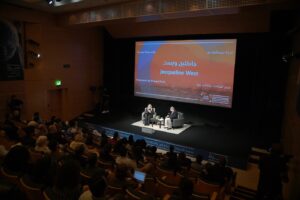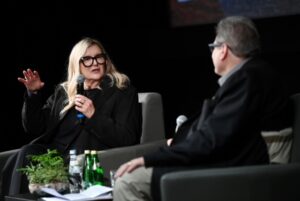Being A Costume Designer Is One Half Design And The Other Exploring The Psychology Of The Characters, Says Qumra Master Jacqueline West
Four-time Academy Award nominee for Best Achievement in Costume Design Qumra Master Jacqueline West described her creative process to emerging filmmakers at Qumra 2023, underlining the importance of studying the characters in-depth, engaging in extensive research and reading every possible material.
“Once you learn all about the film, the characters, you dress them to reveal the onion skins, the multiple layers, and get the actors to the crux of the character,” she says, adding that “costume design is 50 per cent design and 50 per cent psychology.”
Nominated for the Academy Award for Quills (2000), The Curious Case of Benjamin Button (2008), The Revenant (2015) and Dune: Part One (2021), West says she first seeks the approval of her design concepts from the director and only then approaches the actors. There has been little resistance from any directors or actors to her creative approach, which is akin to “being a special shopper for the characters.”
With an outstanding ouvre of works including The League of Extraordinary Gentlemen (2003), State of Play (2009), The Tree of Life (2011), and Seventh Son (2014), among others, West owned her own clothing store and was a sought-after fashion designer in Berkeley, California. That, in turn, was inspired by her mother, also a designer. “I had a mannequin in my room that I dressed instead of dolls,” laughs West, “and I always loved that.”
Though she was strong in science, she changed her major to Art History at college, which in hindsight brings that exceptional attention to detail in West’s designs for films. Her knowledge of art history was also a reason director Philip Kaufman asked her to design the costumes for Henry & June (1990) starring Fred Ward and Uma Thurman.
She says she used a lot of artbooks and looked at paintings, “and I was reading, reading and reading” – a process that West continues to this day for her projects. Kaufman’s advise to West, which is relevant for any aspiring costume designer, is that “when you have an idea for a costume, just make it!”
For independent spirited film that she earlier worked on as well as big budget studio movies, West has the same creative approach. “You must know your characters and dress them inside out. Every character has these onion skins, and you have to know these layers,” says West, who also leaves behind “one talisman for every character that brings out his or her inner richness that tells a story in a quick read. You must also consider the comfort of actors – as they have to do stunts and action. Drawing is conceptual, real clothes have to be alive.”
Known to be a stickler for designing under budget, West does not have a permanent team, although she admits that her daughter, who also joined her in Doha, “has been my secret weapon on many films.”
As a costume designer, West says the most important aspect in her work is “having the right fabric, as it guides the look and feel.” She elaborated on her work for The Curious Case of Benjamin Button, a seminal movie that allowed her to design costumes over a period spanning a hundred years.
For The Revenant, the costume design task was equally daunting, having to design ten sets of the same costume for the first scene they shot. She had to use special techniques, including mixing black wax into every dress to make them look dirty. There was little reference material she could bank on for the film as the costumes of the trappers are not documented.
When it came to Dune, which has a cult following, West looked into the ancient past to design the futuristic costumes as the film’s director Denis Villeneuve, who had already tried out many other designers, did not want a typical sci-fi look. She created what she calls the ‘Mod-evial’ style – where she sought inspiration from the Templars and the medieval world and looked into the future. West is now looking forward to her work with Martin Scorsese for his upcoming film Killers of the Flower Moon.









 Email: info@cyber-gear.com
Email: info@cyber-gear.com